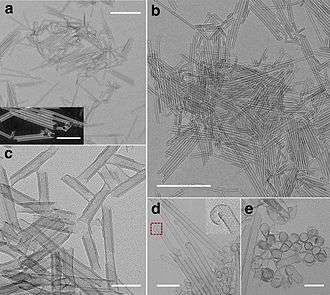Cobalt(II) hydroxide
cobalt(II) hydroxide | |
| Names | |
|---|---|
| IUPAC name
Cobalt(II) hydroxide | |
| Other names
Cobaltous hydroxide, cobalt hydroxide, β-cobalt(II) hydroxide | |
| Identifiers | |
3D model (JSmol) |
|
| ChemSpider | |
| ECHA InfoCard | 100.040.136 |
PubChem CID |
|
| |
| |
| Properties | |
| Co(OH)2 | |
| Molar mass | 92.948 g/mol |
| Appearance | rose-red powder or bluish-green powder |
| Density | 3.597 g/cm3 |
| Melting point | 168 °C (334 °F; 441 K) (decomposes)[1] |
| 3.20 mg/L | |
Solubility product (Ksp) |
1.0×10−15 |
| Solubility | soluble in acids, ammonia; insoluble in dilute alkalis |
| Structure | |
| rhombohedral | |
| Thermochemistry | |
Std molar entropy (S |
79.0 J·mol−1·K−1[1] |
Std enthalpy of formation (ΔfH |
-539.7 kJ·mol−1 |
| Hazards | |
| Safety data sheet | Oxford University |
EU classification (DSD) (outdated) |
|
| R-phrases (outdated) | R20 R21 R22 R36 R37 R38 R43 |
| S-phrases (outdated) | S24 S26 S36 S37 S39[2] |
| NFPA 704 | |
| Related compounds | |
Other anions |
Cobalt(II) chloride Cobalt(II) bromide Cobalt(II) iodide |
Other cations |
Iron(II) hydroxide Nickel(II) hydroxide Copper(II) hydroxide |
Except where otherwise noted, data are given for materials in their standard state (at 25 °C [77 °F], 100 kPa). | |
| Infobox references | |
Cobalt(II) hydroxide or cobaltous hydroxide is the inorganic compound with the formula Co(OH)2. It is a rose-red powder. An unstable blue form, so-called α-Co(OH)2, has also been reported.[3] It is most used as a drying agent for paints, varnishes, and inks, in the preparation of other cobalt compounds, as a catalyst and in the manufacture of battery electrodes.
Preparation
Cobalt(II) hydroxide precipitates as a solid when an alkali metal hydroxide is added to an aqueous solution of Co2+ salt:[4]
- Co2+ + 2 NaOH → Co(OH)2 + 2 Na+
Cobalt(II) hydroxide decomposes to cobalt(II) oxide at 168 °C under vacuum and is oxidized by air.[4] The thermal decomposition product in air above 300 °C is Co3O4.[5][6]
A light blue form can be prepared by elecrolysis of a cobalt(II) nitrate solution with a platinum cathode. The thin layer consists of platelets with partial hexagonal geometry, 300 nm wide and 5-10 nm thick.[7]
Reactions
Like iron(II) hydroxide, cobalt(II) hydroxide is a basic hydroxide. It forms [Co(H2O)6]2+ in acidic aqueous solutions. In strong bases, cobalt(II) hydroxide accepts additional hydroxide ions to form dark blue cobaltates(II) [Co(OH)4]2− and [Co(OH)6]4−.[8]
Structure
Cobalt(II) hydroxide has the brucite crystal structure. As such, the anion and cation packing are like those in cadmium iodide. Cadmium has octahedral molecular geometry.[8] The so-called α-Co(OH)2 is related closely to β-Co(OH)2 but adopts the hydrotalcite structure. As such it contains anions in the interlayers, hence it is not a polymorph. α-Co(OH)2 is a precursor to β-Co(OH)2.[9]

References
| Wikimedia Commons has media related to Cobalt(II) hydroxide. |
- 1 2 Lide, David R. (1998). Handbook of Chemistry and Physics (87 ed.). Boca Raton, Florida: CRC Press. p. 513. ISBN 0-8493-0594-2.
- ↑ "Safety (MSDS) data for cobalt (II) hydroxide". Oxford University. Retrieved 2009-03-27.
- ↑ Lide, David R. (1998). Handbook of Chemistry and Physics (87 ed.). Boca Raton, Florida: CRC Press. p. 454. ISBN 0-8493-0594-2.
- 1 2 O. Glemser "Cobalt(II) Hydroxide" in Handbook of Preparative Inorganic Chemistry, 2nd Ed. Edited by G. Brauer, Academic Press, 1963, NY. Vol. 1. p. 1521.
- ↑ Jayashree, R. S.; Kamath, P. Vishnu (1999). "Electrochemical synthesis of a-cobalt hydroxide". Journal of Materials Chemistry. 9 (4): 961–963. doi:10.1039/A807000H.
- ↑ Xu, Z. P.; Zeng, H. C. (1998). "Thermal evolution of cobalt hydroxides: a comparative study of their various structural phases". Journal of Materials Chemistry. 8 (11): 2499–2506. doi:10.1039/A804767G.
- ↑ P. Benson, G. W. D. Briggs, and W. F. K. Wynne-Jones (1964): "The cobalt hydroxide electrode—I. Structure and phase transitions of the hydroxides". Electrochimica Acta, volume 9, issue 3, pages 275-280. doi:10.1016/0013-4686(64)80016-5
- 1 2 Wiberg, Nils; Wiberg, Egon; Holleman, A. F. (2001). Inorganic Chemistry. Academic Press. pp. 1478–1479. ISBN 0-12-352651-5. Retrieved 2009-03-27.
- ↑ Liu, Zhaoping; Ma, Renzhi; Osada, Minoru; Takada, Kazunori; Sasaki, Takayoshi (2005). "Selective and Controlled Synthesis of α- and β-Cobalt Hydroxides in Highly Developed Hexagonal Platelets". Journal of the American Chemical Society. 127: 13869–13874. doi:10.1021/ja0523338.
- ↑ Ni, Bing; Liu, Huiling; Wang, Peng-Peng; He, Jie; Wang, Xun (2015). "General synthesis of inorganic single-walled nanotubes". Nature Communications. 6: 8756. doi:10.1038/ncomms9756. PMC 4640082. PMID 26510862.
